SARS-CoV-2 Transmission in Alberta, British Columbia, and Ontario, Canada, December 25, 2019, to December 1, 2020
- PMID: 33762027
- PMCID: PMC8134904
- DOI: 10.1017/dmp.2021.78
SARS-CoV-2 Transmission in Alberta, British Columbia, and Ontario, Canada, December 25, 2019, to December 1, 2020
Abstract
Objective: This study aimed to investigate coronavirus disease (COVID-19) epidemiology in Alberta, British Columbia, and Ontario, Canada.
Methods: Using data through December 1, 2020, we estimated time-varying reproduction number, Rt, using EpiEstim package in R, and calculated incidence rate ratios (IRR) across the 3 provinces.
Results: In Ontario, 76% (92 745/121 745) of cases were in Toronto, Peel, York, Ottawa, and Durham; in Alberta, 82% (49 878/61 169) in Calgary and Edmonton; in British Columbia, 90% (31 142/34 699) in Fraser and Vancouver Coastal. Across 3 provinces, Rt dropped to ≤ 1 after April. In Ontario, Rt would remain < 1 in April if congregate-setting-associated cases were excluded. Over summer, Rt maintained < 1 in Ontario, ~1 in British Columbia, and ~1 in Alberta, except early July when Rt was > 1. In all 3 provinces, Rt was > 1, reflecting surges in case count from September through November. Compared with British Columbia (684.2 cases per 100 000), Alberta (IRR = 2.0; 1399.3 cases per 100 000) and Ontario (IRR = 1.2; 835.8 cases per 100 000) had a higher cumulative case count per 100 000 population.
Conclusions: Alberta and Ontario had a higher incidence rate than British Columbia, but Rt trajectories were similar across all 3 provinces.
Keywords: COVID-19; Canada; SARS-CoV-2; coronavirus; epidemiology; infectious disease; transmission.
Figures
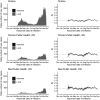

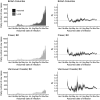
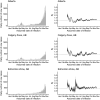
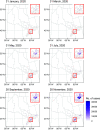
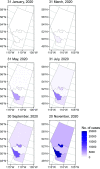
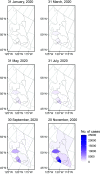
Similar articles
-
SARS-CoV-2 Transmission in Alberta, British Columbia, and Ontario, Canada, January 2020-January 2022.Emerg Infect Dis. 2024 May;30(5):956-967. doi: 10.3201/eid3005.230482. Emerg Infect Dis. 2024. PMID: 38666622 Free PMC article.
-
Correlation of ambient temperature and COVID-19 incidence in Canada.Sci Total Environ. 2021 Jan 1;750:141484. doi: 10.1016/j.scitotenv.2020.141484. Epub 2020 Aug 4. Sci Total Environ. 2021. PMID: 32829260 Free PMC article.
-
Cross-Canada Variability in Blood Donor SARS-CoV-2 Seroprevalence by Social Determinants of Health.Microbiol Spectr. 2023 Feb 14;11(1):e0335622. doi: 10.1128/spectrum.03356-22. Epub 2023 Jan 10. Microbiol Spectr. 2023. PMID: 36625634 Free PMC article.
-
A scorecard for osteoporosis in Canada and seven Canadian provinces.Osteoporos Int. 2021 Jan;32(1):123-132. doi: 10.1007/s00198-020-05554-2. Epub 2020 Jul 25. Osteoporos Int. 2021. PMID: 32712739 Free PMC article. Review.
-
A Canadian perspective on severe acute respiratory syndrome coronavirus 2 infection and treatment: how prevalent underlying inflammatory disease contributes to pathogenesis.Biochem Cell Biol. 2021 Apr;99(2):173-194. doi: 10.1139/bcb-2020-0341. Epub 2020 Oct 7. Biochem Cell Biol. 2021. PMID: 33027600 Review.
Cited by
-
SARS-CoV-2 Transmission Potential and Policy Changes in South Carolina, February 2020 - January 2021.Disaster Med Public Health Prep. 2022 Aug 4;17:e276. doi: 10.1017/dmp.2022.212. Disaster Med Public Health Prep. 2022. PMID: 35924560 Free PMC article.
-
SARS-CoV-2 Transmission in Alberta, British Columbia, and Ontario, Canada, January 2020-January 2022.Emerg Infect Dis. 2024 May;30(5):956-967. doi: 10.3201/eid3005.230482. Emerg Infect Dis. 2024. PMID: 38666622 Free PMC article.
-
SARS-CoV-2 transmission potential and rural-urban disease burden disparities across Alabama, Louisiana, and Mississippi, March 2020 - May 2021.Ann Epidemiol. 2022 Jul;71:1-8. doi: 10.1016/j.annepidem.2022.04.006. Epub 2022 Apr 25. Ann Epidemiol. 2022. PMID: 35472488 Free PMC article.
-
Estimating behavioural relaxation induced by COVID-19 vaccines in the first months of their rollout.PLoS Comput Biol. 2025 Jul 7;21(7):e1013266. doi: 10.1371/journal.pcbi.1013266. eCollection 2025 Jul. PLoS Comput Biol. 2025. PMID: 40623118 Free PMC article.
-
Emergence and spread of SARS-CoV-2 variants of concern in Canada: a retrospective analysis from clinical and wastewater data.BMC Infect Dis. 2024 Jan 29;24(1):139. doi: 10.1186/s12879-024-08997-8. BMC Infect Dis. 2024. PMID: 38287244 Free PMC article.
References
-
- National Post. As the COVID-19 pandemic hit, provinces declared states of emergency. Now many are up for renewal. April 15, 2020. https://nationalpost.com/news/provincial-states-of-emergencies-were-issu.... Accessed May 2, 2020.
-
- The Globe and Mail. Coronavirus March 17: Ontario, Alberta, B.C. declare states of emergency; B.C. closes schools to combat virus spread. March 17, 2020. https://www.theglobeandmail.com/canada/article-the-latest-on-the-coronav.... Accessed April 7, 2020.
-
- Government of Canada. Coronavirus disease (COVID-19): outbreak update (as of December 15, 2020). 2020. https://www.canada.ca/en/public-health/services/diseases/2019-novel-coro.... Accessed December 15, 2020.
LinkOut - more resources
Full Text Sources
Other Literature Sources
Miscellaneous

